index
Index
An index (plural: usually indexes, more rarely indices; see below) is a list of words or phrases ('headings') and associated pointers ('locators') to where useful material relating to that heading can be found in a document or collection of documents. Examples are an index in the back matter of a book and an index that serves as a library catalog.
forward & inverted index
https://www.cnblogs.com/softidea/p/9852048.html
正排索引(forward index)与倒排索引(inverted index)
正排索引(前向索引) 正排索引也称为"前向索引"。正向索引的结构如下:
“文档1”的ID > 单词1:出现次数,出现位置列表;单词2:出现次数,出现位置列表;…………。
“文档2”的ID > 此文档出现的关键词列表。
一般是通过key,去找value。
得到倒排索引的结构如下:
“关键词1”:“文档1”的ID,“文档2”的ID,…………。
“关键词2”:带有此关键词的文档ID列表。
从词的关键字,去找文档。
倒排索引(Inverted Index)
https://www.cnblogs.com/GrantYu/p/3669062.html
倒排索引(Inverted Index)
倒排索引是一种索引结构,它存储了单词与单词自身在一个或多个文档中所在位置之间的映射。
倒排索引通常利用关联数组实现。它拥有两种表现形式:
inverted file index,其表现形式为 {词项,词项所在文档的ID}
full inverted index,其表现形式为 {词项,(词项所在文档的ID,在具体文档中的位置)}
具体实例,假设有三个文档:
D0 = "it is what it is"
D1 = "what is it"
D2 = "it is a banana"
那么,采用inverted file index方式,结果是:
"a": {2}
"banana": {2}
"is": {0, 1, 2}
"it": {0, 1, 2}
"what": {0, 1}
采用full inverted index方式,结果是:
"a": {(2, 2)}
"banana": {(2, 3)}
"is": {(0, 1), (0, 4), (1, 1), (2, 1)}
"it": {(0, 0), (0, 3), (1, 2), (2, 0)}
"what": {(0, 2), (1, 0)}
Python module-Inverted Index
https://legacy.python.org/workshops/1996-11/papers/InvertedIndex.html
Text-search engines provide the ability to quickly search for documents that contain terms in textual data. Commercial text-search engines provide many capabilities but often have large overhead in process size, application complexity, and licensing cost. We have developed a Python module, InvertedIndex, that has a simple Python Application Programming Interface and that provides support for incremental indexing and for stopword, synonym, and stemming databases.






